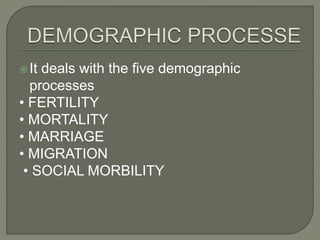Demography
- 1. MD Yusuf Ali
- 2. ? Demography is the °±scientific study of human population in which includes study of changes in population size ,composition and its distribution°±
- 3. ?°∞Demo°± means °∞the people°± and °∞graphy°± means °∞measurement°± ?(Demos = population, Graphy = picture
- 4. ? Health status of a community depends upon the dynamic relationship between number of people, their composition& distribution . ? Planning of health services can be guided by demographic variables, for example: How many health units do we need? How to distribute them in the community in order to be accessible to the target population? What type of manpower is needed?
- 5. ?Size: increase or decrease ? Composition: sex and age group ? Distribution: territory
- 6. ?POPULATION CENSUSES ?NATIONAL SAMPLE ?SURVEYS REGISTRATION ?VITAL EVENTS
- 7. ? Demography ? Economic Activity ? Literacy & Education ? Housing & Household ? Urbanization ? Fertility and Mortality ? Scheduled Castes and Scheduled Tribes ? Language, Religion & Migration
- 8. ?It deals with the five demographic processes ? FERTILITY ? MORTALITY ? MARRIAGE ? MIGRATION ? SOCIAL MORBILITY
- 9. ?High stationary (first stage ): this stage is characterized by a high birth rate and high death rate ,no any change in size and population .Indian was in this stage till 1920. ? Early expending (second stage ): the death rate begins to decline (starts decreasing )and birth rate no change . initial increase in population
- 10. ?Late expanding (third stage): the birth rate begins to decline while the death rate still decreases . continue increase in population ? Low stationary (fourth stage ) : This stage is characterized by a low birth rate & low death rate .stability in population . Declining (fifth stage ):in the declining stage birth rate is lower then the death rate .fall in population
- 11. ?Primary data collection :collection is done by the individual by using the methods such as : ?Observation ? Interviews ? Questionnaires ? Diaries .
- 12. ? Census ? National survey ? Registration of vital events ? Demographic studies ? Records
- 13. ? Data is collection directly or indirectly from population . The data collected directed from individuals by face to face survey . ? Data collected during census. ? Data related to health from an individual. ? Data related to illness from an individual. . ?
- 14. ? Data taken from hospital records ? The data collected need to be arranged in table ,charts ,diagrams, graphs picture
- 15. ? In 1872 The Census of India ?2011 th is the 15th Census and 7th after Independence. the first Census was held in India.
- 16. 1 Name of person 8 Marital Status 2 Relationship to Head 9 Place of Birth 3 Father°Øs Name 1 0 Nationality as Declared 4 Mother°Øs Name 11 Present address of usual residence 5 Spouse°Øs Name 12 Duration of stay at present address 6 Sex 13 Permanent Residential Address 7 Date of Birth 14 Occupation / Activity 15 Educational Qualification
- 17. 1 Name of person 8 Marital Status 2 Relationship to Head 9 Place of Birth 3 Father°Øs Name 1 0 Nationality as Declared 4 Mother°Øs Name 11 Present address of usual residence 5 Spouse°Øs Name 12 Duration of stay at present address 6 Sex 13 Permanent Residential Address 7 Date of Birth 14 Occupation / Activity 15 Educational Qualification
- 18. ?Thank you


















